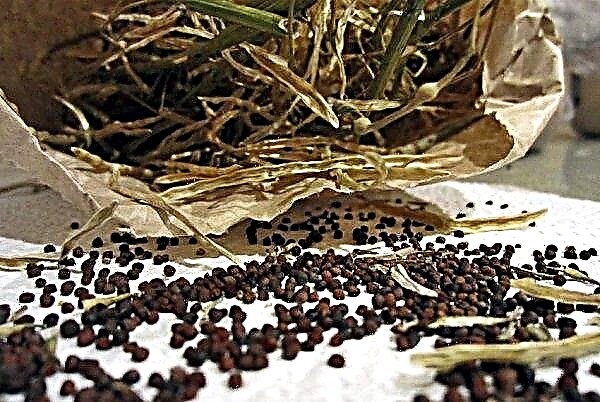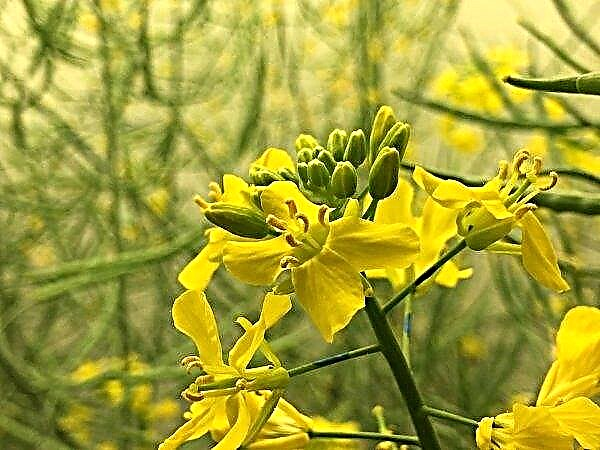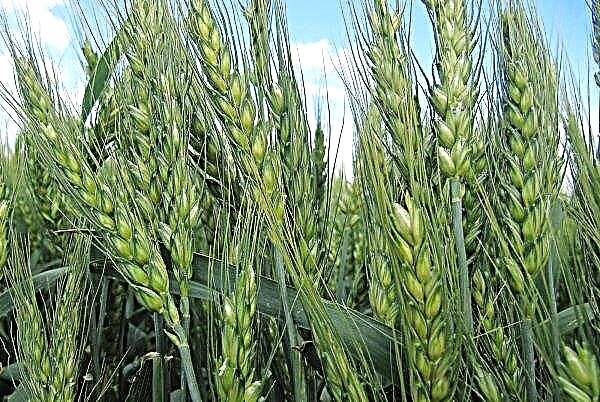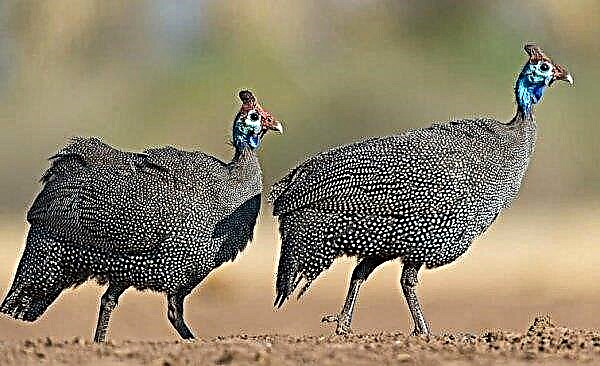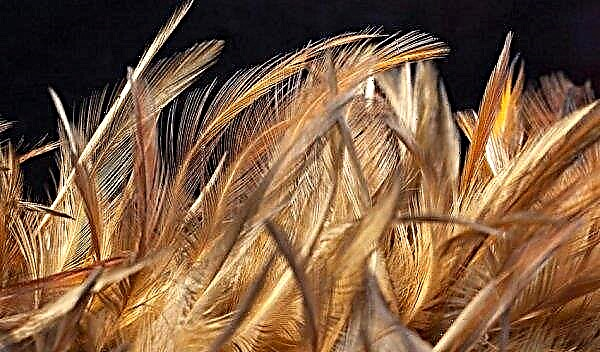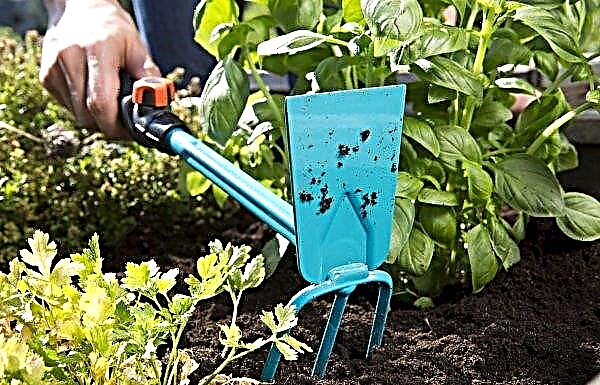Calathea Lansifolia is a type of houseplant that has an exotic appearance of leaves and flowers. About the characteristic features of the culture, methods of reproduction, the rules of growing and caring for it, read below.
Botanical description of the plant
Calathea Lansifolia is a representative of the genus of monocotyledonous flowering crops from the Marantovian family. Homeland perennial plants are tropical forests of South America.
The shoots of the underground culture, forming a rhizome, from which rosettes of leaf plates extend, containing just one leaf. Stolons are formed on the roots - rounded growths that contain a supply of water and nutrients.

The color of the plant is colorful, exotic. On the outside of the leaf is green, with black symmetrical spots, on the back is a purple color.
The culture grows to 75 cm. The leaves grow only a year, and then die off and are replaced by new ones.
With proper care, calathea blooms from May to August. Flowers are purple, white, red - they are formed in the axils of leaf plates.
Video: Calathea Lansifolia
What to do immediately after buying a flower?
After buying a houseplant, the first thing you need to do is transplant it into another pot and change the soil, which may not be enough fertilizer for further growth of the crop. Next, choose a suitable place to grow. The east and west sides of the room are best suited.
Important! When growing calathea on a window with a southern arrangement, its leaves will lose color. Also, you can not put the plant on the windowsills from the northern part of the house, otherwise, due to the lack of heat and light, its growth will stop.
Conditions for successful growing at home
In order for the calathea to develop well and delight with a beautiful appearance, it is necessary to provide it with sufficient lighting, moisturizing and observing the temperature regime, which will favorably affect the development of this indoor plant.
Lighting
The culture does not tolerate direct sunlight: due to their influence, the shade of the sheet plates fades, but the brightness of the color is also lost in the shade. For kalatea, diffused lighting is necessary, therefore, at the place of its cultivation, it is necessary to make a partial shade, which is created by hanging the album sheet on the window so that the light is filtered through paper.
Ventilation
Airing should be daily, 10-15 minutes. In the summer, plants can be taken out to the balcony or porch.
Temperature mode
The optimum temperature for growing is from + 20 ° C to + 27 ° C in the summer and from + 16 ° C in the winter. Culture does not accept sharp changes in temperature and drafts.
Home Care
The development and growth of the plant depend on the proper care. It is especially important to observe the timing of fertilizing and watering so that the calathea blooms on time.
Watering
Watering the plant is carried out with water protected for 48 hours, the temperature of which ranges from + 20 ° C to + 25 ° C. A root watering technique is used to prevent excess wetting of the leaf plates.
The procedure is carried out as the topsoil dries. In a hot period, the frequency of watering should be once every 3 days, in the cold period, watering is carried out every 7 days.
Important! In order to prevent waterlogging, it is necessary to drain the accumulated water from the pan installed under the pot.
Spraying
In the room where the culture is grown, it is necessary to maintain air humidity up to 90%. To do this, place the plant in aquarium conditions, which is very problematic when growing in the house, so daily spraying of water over the flower is carried out. You need to try to do the procedure with a minimum hit on the surface of the flower, because the leaves of kalatea do not tolerate overmoistening.
Once every 3-4 days, you can wipe the culture with a damp cloth: the procedure is carried out with gentle movements, moving from the base to the top of the leaf plate.
Top dressing
From March to October, it is necessary to feed the plant every two weeks. From November to February, fertilizer should be applied once every 1.5 months.
It is necessary to alternate organic and mineral fertilizers. Organic fertilizer is prepared from mullein - 100 g per 1 liter of water, 2 g of superphosphate can be added during the formation of buds. For mineral fertilizers, it is best to purchase a ready-made product - NPK Stimulus, which is used in this proportion, is perfect: 1 cap of the drug per 1.5 liters of water.
Pruning
Calathea Lansifolia does not need regular pruning. It is only necessary to carry out timely removal of shriveled or damaged leaves.
Transfer
Culture transplantation takes place in February or March. The procedure is carried out annually for 4 years after planting a sprout. An adult plant requires a transplant once every 3 years.
In order for the transplanted culture to have enough room for growth, it is necessary to take a pot 2 cm larger than the previous one. Usually they take a wide pot that looks like a bowl - it will contribute to the growth of the root system and the reproduction of offspring.For transplantation, a soil substrate is prepared, which consists of:
- turf land - 2 kg;
- peat - 1 kg;
- charcoal - 500 g;
- river sand - 500 g.
Before transplanting, it is necessary to soak the soil in a pot with a plant in order to safely remove it from the tank without damaging the rhizome. You can clean the roots of the soil in a basin of water, after which they are reviewed for the presence of rot. Having cut off all damaged and rotten parts, the slices are sprinkled with wood ash.
Transplant Process:
- At the bottom of the pot pour a drainage base of pebbles in one layer, about 1-2 cm.
- Pour a layer of soil substrate 2 cm.
- Introduce the plant into a pot and fill it with soil substrate to the top without tamping.
Breeding
Reproduction of calanhea Lansifolia is carried out in three ways:
- cuttings;
- rhizome division;
- seeds.
Root division
Reproduction by dividing the rhizome becomes possible after the plant reaches 3 years of age. At this time, the rhizome itself is divided into several parts, each of which forms its own trunk, which allows you to get new plants.
Important! The cutter blade must be decontaminated — it is wiped with a cotton swab dipped in alcohol.
To divide the roots into parts, you must first clean them from the soil by washing under running water, and then dry them thoroughly. Fused roots must be cut with a knife. The cutting process should be quick and clear, you must make sure that the knife is well sharpened, because a dull tool can cause unnecessary injuries during trimming.
After cutting the rhizome into parts, the places of the slices are sprinkled with chopped wood ash, so that the plant does not get sick with infectious diseases.
Each root must be planted separately in a pot filled with soil substrate, consisting of 2 parts of peat and 1 part of river sand.

Planting process and further care for the separated root:
- it is necessary to introduce the root into the pot and sprinkle with a mixture of peat and sand;
- after planting, water the container with plenty of settled water at a temperature of + 20 ° C;
- further watering is carried out after complete drying of the soil, once every 4 days;
- the planted root should be covered with cling film, in which several small holes should be made for oxygen to be accessed;
- the film should be removed after the appearance of a green sprout.
Transplantation into another container should be carried out after the appearance of 1-2 leaves.
Cuttings
Cuttings are obtained by separating leaf sockets from the mother plant. The complexity of this method of reproduction is that the separated cuttings have a growth point, and he does not have a rhizome, so the process is very time-consuming.
The shank is planted in wet sand and placed under a hood, which is removed daily for 20 minutes for ventilation. Watering is carried out as the sand dries, usually every 3-4 days. It can be transplanted into a new pot after 1-2 new leaves appear on the handle, which will testify to its rooting.

Planting seeds
Seeds are harvested in late autumn, when the flower stalks are fully ripe. The seeds are yellow, have the shape of balls. After collecting, they are dried for several hours on the balcony.
Sowing of seed material is carried out in a shallow container, the dimensions of which depend on the number of seeds for sowing. Soil for sowing is prepared from turf land (2 parts) and river sand (1 part). The soil mixture is poured to the top of the tank and the seeds are sown, observing a distance of 3 cm between them. The seeds must be pressed firmly to the ground, and then watered abundantly. Capacities with crops are placed in a warm place with a temperature of + 25 ° C. The first seedlings should be in 2-3 weeks - when two leaves appear on them, the plants can be transplanted into separate peas.

Problems that may occur during cultivation
During the cultivation of calanheum Lansifolia, the following problems may occur:
- lack of flowering;
- the formation of dry spots on the leaves;
- yellowing of leaf plates;
- leaves become thin.
Lack of flowering
Lack of flowering may be due to poor maintenance environment. It is necessary to transfer the pot to a warmer and wetter place - then the calathea will begin to bloom.
To recreate the optimal flowering conditions, you can place the pot of calathea in a basin of water so that the water does not fill the pot.

Curled leaves or dry spots
If the leaf plates began to curl into a tube and dry spots appeared on them, which eventually spill out, turning into holes, then the plant does not have enough moisture. Also, drafts or too cold growing conditions may be the causes of leaf curl.
Methods for controlling leaf curl:
- increasing the frequency of watering up to once every two days;
- increasing air humidity by spraying water over a flower from a spray bottle 2 times a day, daily;
- increase in air temperature up to + 20 ° С.
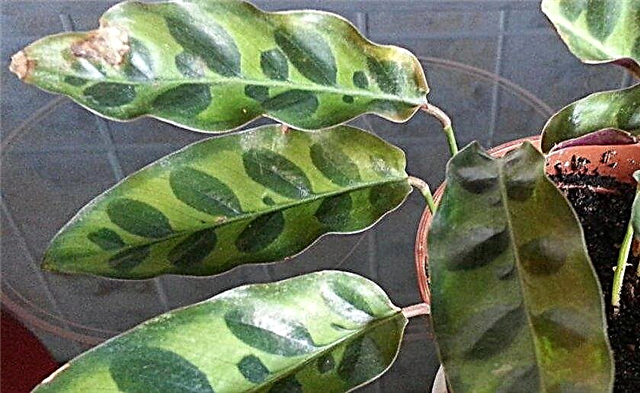
Yellow foliage
If the foliage turned yellow on the calanhe of Lansifolia, then there is a lack of fertilizer or, conversely, an overabundance of it. Eliminate this phenomenon will help to clearly adhere to the feeding schedule. Fertilizer frequency should be no more than 1 time in two weeks from spring to autumn and 1 time in 6 weeks in winter.
If the feeding schedule is observed, it means that the leaves turn yellow from an overabundance of fertilizing - in this case, you need to lower the applied dose of fertilizer by half. For example, when introducing the mineral preparation “Stimulus NPK”, instead of 1 cap, you need to take half and also dilute with 1 liter of water.

Leaves acquired a thin elongated shape
If the leaves acquired a thin elongated shape and became lethargic, then the plant has a nitrogen deficiency. Symptoms appear primarily on old leaves, but over time, a lack of nitrogen affects the entire plant - not only in thinning, but also in the appearance of a red tint on the leaf veins.
You can fix the problems by observing the fertilizer schedule with the mandatory alternation of mineral and organic fertilizers. You can increase the level of nitrogen by adding organic fertilizer based on bird droppings - 100 g per 1 liter of water.
Did you know? Calathea is known to the world under the name “prayer flower” because of its ability to change the position of leaves. In the morning, the leaf plates are in the lower position, and in the evening they stretch upward, showing their wrong sides.
Yellow spots
Yellow spots may appear due to the spread on the calathe of the scutellum - this is an insect up to 2 mm long. The scabbard eats leaf juice, which leads to their slow death. Due to the effects of the parasite, the plant stops developing.
Fighting the scale shield:
- Removing depleted, damaged leaf blades.
- Adults are removed from the leaves manually using a cotton pad soaked in a soap solution (20 g of liquid soap in 200 ml of water). With gentle movements, the plant is wiped from the base to the top.
- Spraying with Aktara insecticide - 4 g per 5 l of water.

Dark spots
The manifestation of dark spots in the middle of the leaf may indicate the appearance of a fungus, which was formed due to overmoistening of the soil.
Fungal control measures:
- Loosening the soil in a pot to provide ventilation of the root system and better drying of the soil.
- Removal of affected leaves.
- During the fight against fungus, provide ventilation for 10 minutes in the morning and evening.
Typically, the problem of waterlogging of the soil goes away within 2-3 weeks, subject to the above measures to combat fungus. Calathea Lansifolia is a beautiful plant that is well grown at home, subject to the rules of care. The beauty and health of the culture largely depends on the location in the house and compliance with high humidity.
Calathea Lansifolia is a beautiful plant that is well grown at home, subject to the rules of care. The beauty and health of the culture largely depends on the location in the house and compliance with high humidity.


